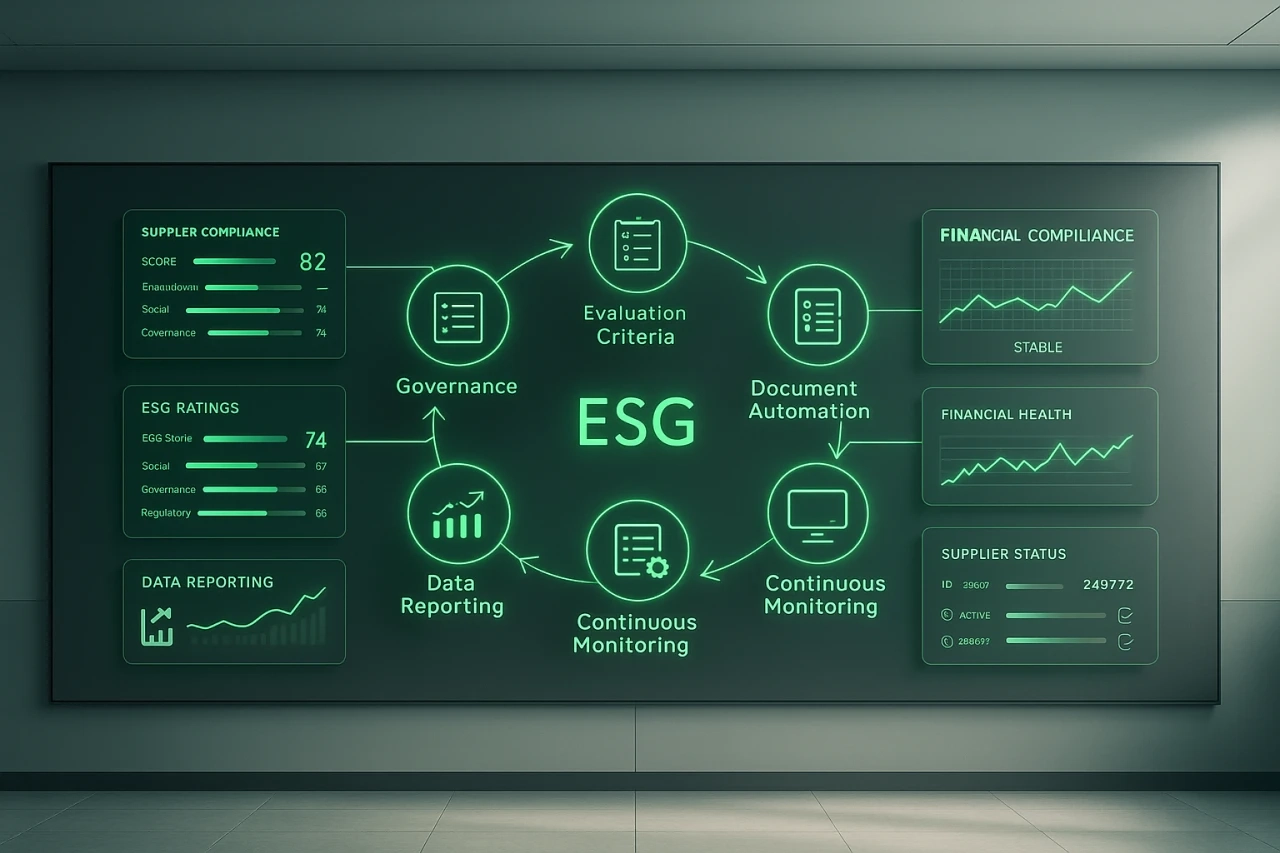Deploying a TPRM Platform in Private Companies: Proven Methodology for Effective Third-Party Governance

In a context where TPRM programs require executive-level support to succeed, deploying a TPRM platform is a major strategic challenge. While deployment in the public sector has its own regulatory specificities, multi-site private companies face distinct organizational challenges that call for a tailored methodological approach. This structured methodology transforms third-party evaluation into a true third-party governance lever, going beyond mere documentation compliance to build long-term operational resilience.
The European regulatory changes in 2025, particularly the implementation of DORA and NIS 2, make this strategic imperative even more critical. Multi-site companies face increasing complexity: coordination between subsidiaries, harmonization of evaluation processes, and standardization of compliance criteria across the group. This reality calls for a rigorous methodological approach that adapts to organizational specificities while maintaining global coherence in third-party risk management.
Organizational Diagnosis Prior to Deployment
Before initiating the deployment of a TPRM platform, a thorough diagnosis of the current situation is essential. This audit phase often reveals fragmented evaluation processes across departments, generating costly redundancies and critical blind spots. Identifying internal stakeholders is a crucial prerequisite: procurement, compliance, legal, IT, and executive teams must align on a shared vision of third-party risk management.
The mapping of existing tools often exposes a fragmented landscape: scattered Excel spreadsheets, siloed business solutions, and time-consuming manual processes. This analysis helps quantify the potential gains of a unified approach and anticipate organizational resistance.
This diagnostic phase frequently uncovers significant gaps between stated practices and operational reality. The organizational audit should also identify available internal expertise: legal knowledge, risk analysis capabilities, dedicated IT resources. This human resource mapping directly influences deployment strategy and the need for external support.
In the construction sector, document management is a major challenge. Teams face time-consuming manual collection of subcontractor documents, risking errors in critical certifications. This reality drives the adoption of a structured deployment methodology, enabling efficient coordination between job sites and enhanced traceability of multi-tier stakeholders.
Ready to structure your TPRM diagnosis?
Discover how our collaborative evaluation methodology turns the preliminary analysis into a competitive advantage.
Phase-Based Deployment Methodology for Private Companies
Phased deployment is the cornerstone of a successful implementation. This sequential approach, validated through the experience of over 450,000 managed and shared third parties globally, minimizes operational risk while maximizing user adoption. The selection of the pilot scope is based on business criticality: financial impact, regulatory exposure, and sector-specific best practices complexity.
The pilot phase focuses efforts on strategic partners, enabling validation of workflows with business users and fine-tuning settings before scaling. This iterative approach facilitates the identification of friction points and optimization of collaborative due diligence processes.
The industrial sector illustrates this phased methodology perfectly. Companies often prioritize the evaluation of their critical suppliers based on environmental requirements, particularly ICPE (Classified Installations for Environmental Protection). This strategic prioritization demonstrates the platform’s added value quickly, facilitating subsequent expansion to the entire industrial supply chain.
Measurable gains from this phased approach include significant improvements in deployment time and user adoption rates, according to EY, which identifies AI as a key accelerator in TPRM compared to traditional deployments.
The rollout phase requires special attention to sector-specific features. Each industry has unique regulatory requirements: construction focuses on certification traceability, industry emphasizes environmental compliance, and retail optimizes international marketplace management. This diversity demands customized workflows while maintaining overall methodological consistency. Integration with existing systems (ERP, CRM, procurement tools, SRM) is also a critical success factor, requiring thorough technical planning from the pilot stage.
Where do you really stand in your third-party risk management?
Assess your organization’s potential with our personalized diagnosis.
Change Management and Organizational Adoption
Supporting operational teams is key to successful TPRM deployment. Role-based training meets specific needs: procurement teams value operational efficiency, compliance teams focus on normative compliance, and executives seek consolidated risk insights.
Managing resistance to change requires transparent communication of business benefits. Automating repetitive tasksfrees up time for higher-value activities, a highly persuasive argument for operational teams. Demonstrating tangible productivity gains encourages buy-in and accelerates adoption.
The retail sector shows the effectiveness of this approach. International chains face complex regulatory challenges that demand personalized support strategies to comply with national regulations. This approach significantly reduces supplier fatigue through standardized evaluation processes.
Integrating custom intelligent workflows facilitates this transition by automating complex processes while maintaining the flexibility needed for sector-specific nuances.
Resistance to change varies by user profile. Operational teams fear increased process complexity, while executives worry about sourcing delays.
Targeted communication is essential:
- Concrete time-saving demonstrations for operational staff,
- Executive dashboards for leadership,
- Proof of enhanced regulatory compliance for legal teams.
Personalized support also includes the creation of internal “champions” who can relay training and address daily adoption issues.
Performance Measurement and Continuous Optimization
Measuring deployment performance relies on precise deployment KPIs: user adoption rate, reduction in processing times, improvement in regulatory alignment, and fewer third-party-related incidents. These quantifiable metrics assess ROI and enable ongoing strategic adjustments.
The measurable ROI of a well-deployed TPRM platform includes significant gains in operational efficiency and risk detection, according to consolidated feedback. Automating evaluation processes helps to drastically reduce processing times and improve evaluation quality.
Continuous optimization incorporates regulatory changes, including DORA and NIS 2, which reshape risk managementrequirements for critical infrastructure. This regulatory adaptability is a decisive competitive edge in a constantly evolving regulatory landscape.
Anticipating Regulatory Developments
Regulatory adaptability is a decisive competitive edge in a constantly evolving regulatory landscape. Leading companies integrate proactive regulatory monitoring into their implementation strategy, anticipating future obligations rather than reacting to them. This preventive approach avoids emergency compliance costs and transforms regulatory constraints into competitive differentiators. The TPRM platform thus becomes a strategic anticipation tool, capable of automatically adjusting evaluation criteria to new sector requirements.
Aprovall’s cross-sector example, with 450,000 third parties managed worldwide, illustrates these benefits: reduced supplier fatigue through shared evaluations, improved operational resilience through continuous monitoring, and strengthened competitive positioning through differentiated third-party relationship management.
Transform your TPRM approach today
Discover how our collaborative platform optimizes each stage of your deployment to maximize your return on investment.
These articles might interest you
-
 16 July 2025TPRM & Innovation: How Procurement Departments Are Becoming Catalysts for Product PerformanceSecteurInnovation is no longer a luxury. For industries such as manufacturing, construction, luxury goods, or retail, it is a strategic necessity — essential for differentiation, regulatory compliance, and staying competitive in increasingly volatile markets. As products become more complex and development cycles accelerate, Procurement Departments are being called to the forefront. Their mission goes far […]
16 July 2025TPRM & Innovation: How Procurement Departments Are Becoming Catalysts for Product PerformanceSecteurInnovation is no longer a luxury. For industries such as manufacturing, construction, luxury goods, or retail, it is a strategic necessity — essential for differentiation, regulatory compliance, and staying competitive in increasingly volatile markets. As products become more complex and development cycles accelerate, Procurement Departments are being called to the forefront. Their mission goes far […]Read more
-
 15 April 2025Supplier Evaluation in the Public Sector: A Strategic Governance ChallengeSecteurThe public sector accounts for a significant portion of economic activity in France and involves a large number of contract holders. As such, public sector actors face critical challenges in managing supplier relationships—especially since third-party qualification has become a cornerstone of public procurement strategies. Beyond basic oversight, it now forms part of a broader approach […]
15 April 2025Supplier Evaluation in the Public Sector: A Strategic Governance ChallengeSecteurThe public sector accounts for a significant portion of economic activity in France and involves a large number of contract holders. As such, public sector actors face critical challenges in managing supplier relationships—especially since third-party qualification has become a cornerstone of public procurement strategies. Beyond basic oversight, it now forms part of a broader approach […]Read more
-
 02 June 2025The 6 Pillars of an Effective Supplier Evaluation SolutionSecteurAccording to a 2025 Accenture study, 63% of companies are undergoing transformation. As a result, CIOs, procurement managers, and compliance officers are rethinking their approach to third-party governance. In both public and industrial sectors, it is no longer just about collecting administrative documents, but about structuring supplier relationship management to sustainably strengthen operational resilience. Adopting a collaborative evaluation solution based […]
02 June 2025The 6 Pillars of an Effective Supplier Evaluation SolutionSecteurAccording to a 2025 Accenture study, 63% of companies are undergoing transformation. As a result, CIOs, procurement managers, and compliance officers are rethinking their approach to third-party governance. In both public and industrial sectors, it is no longer just about collecting administrative documents, but about structuring supplier relationship management to sustainably strengthen operational resilience. Adopting a collaborative evaluation solution based […]Read more
-
 14 January 2025ESG and Supply Chain: Emerging Challenges for 2025SecteurLa transformation ESG révolutionne la supply chain en 2025, devenant un impératif stratégique pour toute entreprise moderne. La directive CSRD, entrée en vigueur depuis janvier 2024, impose aux entreprises européennes une transparence totale sur leurs impacts environnementaux et sociétaux. Cette évolution réglementaire majeure s’accompagne de nouvelles exigences comme le CBAM (Carbon Border Adjustment Mechanism) et […]
14 January 2025ESG and Supply Chain: Emerging Challenges for 2025SecteurLa transformation ESG révolutionne la supply chain en 2025, devenant un impératif stratégique pour toute entreprise moderne. La directive CSRD, entrée en vigueur depuis janvier 2024, impose aux entreprises européennes une transparence totale sur leurs impacts environnementaux et sociétaux. Cette évolution réglementaire majeure s’accompagne de nouvelles exigences comme le CBAM (Carbon Border Adjustment Mechanism) et […]Read more
